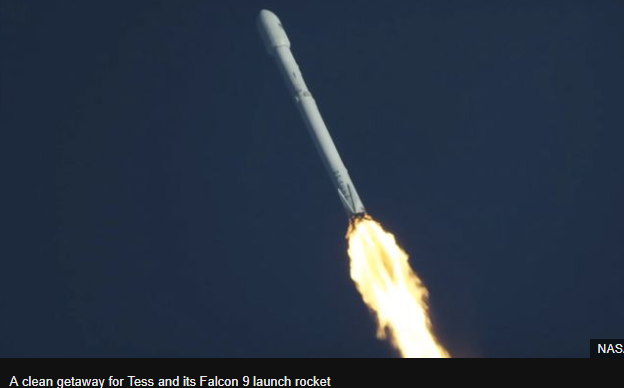
The US space organization's Tess satellite has propelled from Cape Canaveral in Florida set for discover a large number of new universes past our Solar System.
The mission will study an awesome swathe of stars, planning to get the plunges in splendor that happen while circling planets navigate their countenances.
Tess will likely arrange a list that different telescopes would then be able to center in around for more nitty gritty examination.
"Tess is outfitted with four exceptionally touchy cameras that will empower it to screen almost the whole sky," said George Ricker, the mission's foremost agent from the Massachusetts Institute of Technology, which drives the venture.
"The sorts of planets that Tess will distinguish are uncovered by a procedure called a travel. We can see the shadow, successfully, of the planet as it goes before its host star."
Nasa's most recent space telescope went up on a SpaceX Falcon 9 rocket at 18:51 neighborhood time (22:51 GMT; 23:51 BST).
The Transiting Exoplanet Survey Satellite (Tess) should have left on Monday, however the rocket organization had needed some additional opportunity to explore an issue associated with the dispatch vehicle's direction framework.
Wednesday's 49-minute flight put the satellite on an exceptionally circular way around the Earth. Mission organizers have composed a novel circle that will see the observatory corralled by the gravity of the Moon. This will prompt it utilizing next to no fuel to oversee tasks, empowering the mission to continue working for several decades, or for whatever length of time that Nasa discovers an incentive in its science.
Tess follows in the strides of Kepler, a momentous space telescope propelled in 2009.
It additionally utilized the travel method to affirm in excess of 2,000 supposed exoplanets. Yet, Kepler, for its essential mission in any event, just took a gander at a little fix of sky, and the vast majority of its disclosures were basically too far away or excessively diminish, making it impossible to allow additionally examine.
The Tess methodology will be distinctive on various fronts. As a matter of first importance, it is a wide-field review.
Its cameras will examine huge portions of the sky more than 27-day time spans, taking in 85% of the sky in two years.
"Over those initial two years, which is the ostensible mission for Tess, we're hoping to include a large number of planets; something like 2,000-3,000 planets that are unquestionably beneath the extent of Jupiter, and the greater part of them underneath the span of Neptune. Along these lines, the kind that have the potential for being the earthly sort universes that we're most intrigued by," MIT collaborator Jennifer Burt revealed to BBC News.
Every one of the revelations will go into a list that different observatories would then be able to mine. "Consider it a telephone directory; you'll have the capacity to look into the ones that intrigue you," said Tess delegate science executive, Sara Seager, additionally of MIT. "Be that as it may, it's not simply amount; it's quality too - in light of the fact that the planets we do discover will be sufficiently brilliant and sufficiently close to Earth that we truly can do catch up estimations with them."
Tess' main goal is opportune. The following couple of years will see another age of super-telescopes come online that have the advancements to test the airs of close-by universes.
Researchers will search for gases that are potential "biomarkers" - the concoction marks, for example, sub-atomic oxygen, methane and water that could demonstrate the nearness of lifeforms.
Maybe the key on-screen character in this field will be the successor to Hubble - the James Webb space observatory, due in circle from 2020. Its broad essential mirror and infrared instruments appear to be superbly tuned for the activity.
Yet, there will be others too, particularly in Europe where exoplanet science is extremely solid.
The ground-based European Extremely Large Telescope, with its extensive essential mirror, will surely be focusing on Tess revelations when it ends up operational in the mid 2020s. And afterward there is the as of late chosen European Space Agency telescope known as Ariel, which will dispatch in the late 2020s with the particular aspiration of contemplating exoplanet climates.
"Tess will be critical for us," said Ariel's important examiner Giovanna Tinetti from University College London, UK. "Specifically, it is normal that some super-Earths will be found around brilliant stars by Tess, and it's reasonable these will be completely extraordinary focuses for Ariel," she revealed to BBC News.
Congratulations @hamzabashirahmad! You have completed some achievement on Steemit and have been rewarded with new badge(s) :
Click on any badge to view your own Board of Honor on SteemitBoard.
For more information about SteemitBoard, click here
If you no longer want to receive notifications, reply to this comment with the word
STOPCongratulations @hamzabashirahmad! You received a personal award!
You can view your badges on your Steem Board and compare to others on the Steem Ranking
Vote for @Steemitboard as a witness to get one more award and increased upvotes!